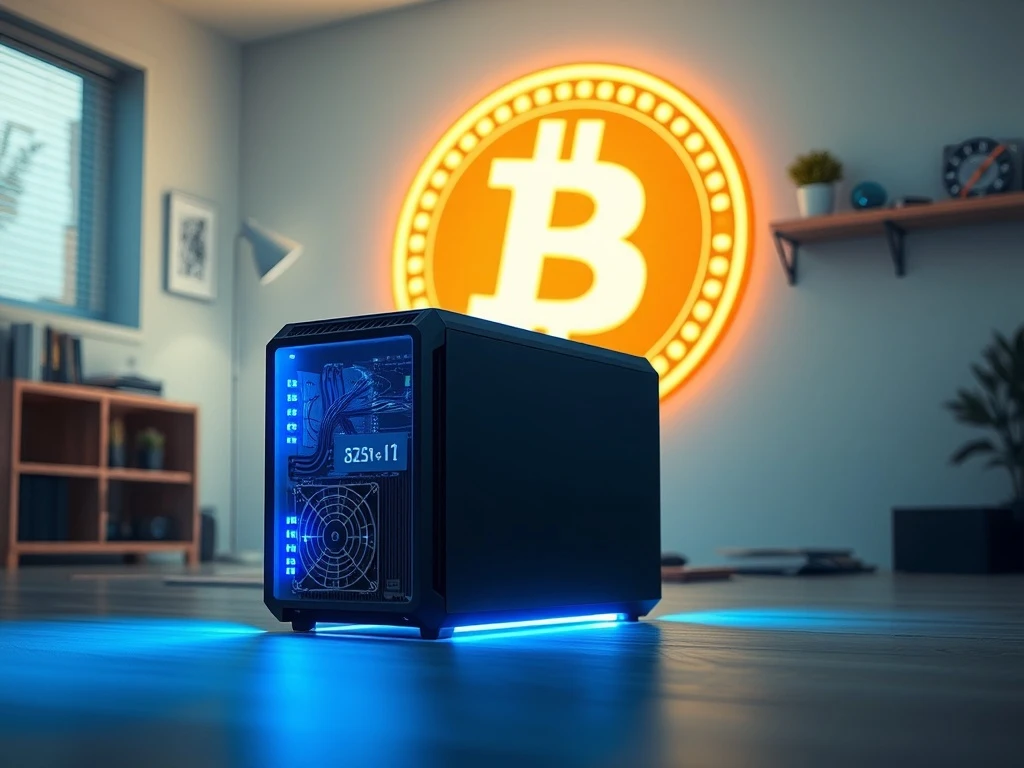Solo Bitcoin Mining: Unlocking Astonishing Block Rewards with Smart Setups

Are you fascinated by the world of cryptocurrency and the idea of earning Bitcoin directly? The buzz around solo Bitcoin mining is growing, with whispers of small setups achieving surprisingly big wins. It sounds almost too good to be true, especially with the Bitcoin network’s immense scale. But recent events suggest that a combination of cutting-edge technology and a touch of luck is making solo Bitcoin mining a viable, albeit challenging, endeavor for some.
The Astonishing Rise of Solo Bitcoin Mining Wins
In a landscape dominated by massive mining farms and powerful pools, individual solo Bitcoin mining operations are defying the odds. Despite the Bitcoin network’s hashrate hovering near all-time highs, individual miners are successfully securing full block rewards. This isn’t just a one-off anomaly; it’s a recurring phenomenon that has caught the attention of the crypto community.
Consider these compelling examples:
- Just last week, a solo miner, operating through the Solo CK pool, successfully mined block 907,283. This single win netted them the full 3.125 BTC reward, valued at over $372,000 at the time, plus an additional $3,436 in transaction fees.
- Prior to that, in July, another miner with a modest 2.3 petahashes of power claimed a full block reward.
- Similar successful solo endeavors were recorded in June, March, and February, painting a picture of consistent, if rare, triumphs.
These victories highlight a fascinating trend: while the overall competition intensifies, the dream of a significant Bitcoin block reward remains alive for the determined individual.
The Engine of Success: Efficient ASIC Miners
What’s behind these remarkable solo wins? According to Samuel Li, chief technology officer of ASICKey, the key lies in the evolution of hardware. “We’re seeing solo miners win blocks not because of sheer luck alone, but because they’re running powerful, efficient hardware,” Li explained. Modern ASIC (Application-Specific Integrated Circuit) miners are designed to deliver substantial hashrate without the exorbitant power consumption of older setups. This crypto mining efficiency is a game-changer for smaller operations.
ASICKey’s own hardware line, introduced last November, exemplifies this shift:
| Model | Hashrate (TH/s) | Power Draw (Watts) | Estimated Monthly BTC Profit | Estimated Monthly Altcoin Profit (e.g., Dash) |
|---|---|---|---|---|
| KEYMINER A1 | 1,100 | 650 | ~$1,200 | Up to ~$3,800 |
| KEYMINER X | 2,300 | 1,300 | – | – |
| KEYMINER PRO | 5,800 | 2,800 | Up to ~$6,300 | – |
These figures demonstrate how advanced ASIC miners can generate significant returns, making the prospect of solo mining more appealing. The focus on power efficiency means lower operating costs, which is crucial for profitability, especially for single setups.
Understanding the Odds: Is Solo Mining a Lottery?
Despite the technological advancements and individual successes, it’s important to understand the underlying statistics. The Bitcoin hashrate, which measures the total computational power dedicated to mining, is currently around 902 exahashes per second (EH/s), near its all-time peak. This indicates immense competition.
Samuel Li cautions that while efficiency has improved, the “fundamental odds haven’t shifted much.” He states, “Solo mining is still mostly a lottery, unless you control tens of PH/s, which is realistically the bare minimum for having a measurable statistical shot at success within a reasonable time frame.” To put it into perspective, a miner with one petahash (PH/s) of hashpower has approximately a 1 in 650,000 chance of solving a block every 10 minutes, given today’s network hashrate. One petahash is equivalent to 1,000 terahashes (TH/s).
So, while the individual wins are inspiring, they remain a testament to both efficient hardware and a significant dose of luck. For most, joining a mining pool still offers a more consistent, albeit smaller, income stream.
Beyond Profit: Why Miners Choose to Go Solo
If the odds are so stacked, why are some miners choosing to go solo? Li confirms a “modest resurgence” of interest, driven by a mix of motivations:
- The Allure of a Big Reward: For some, the possibility of winning a full 6.25 BTC (plus fees, in the post-halving era) is a transformative prospect that outweighs the low probability. It’s akin to a high-stakes lottery ticket.
- Ideological Decentralization: A significant driver for many is the desire to contribute to the Bitcoin network’s decentralization. By operating independently of large mining pools, solo miners embody the permissionless participation ethos that underpins Bitcoin’s original vision.
- Independence and Control: Solo miners retain full control over their operations and rewards, free from pool fees or policies.
The Broader Mining Landscape: Pools vs. Solo Aspirations
The majority of Bitcoin’s hashrate is controlled by large mining pools. Data from Hashrate Index reveals the current dominance:
- Foundry USA: 29.3%
- AntPool: 16.2%
- ViaBTC: 12.0%
- F2Pool: 11.6%
This concentration of power raises concerns about network centralization. If a single pool, or a few acting in concert, were to control over 50% of the hashrate, they could theoretically execute a 51% attack, potentially double-spending coins and undermining network trust. While rare and costly, this risk underscores the importance of a distributed hashrate.
This is where solo miners, despite their small individual contributions, play a crucial role. “Ultimately, more solo miners—especially those operating on clean energy and efficient hardware—could represent a healthier, more decentralized Bitcoin network, which is aligned with the original vision of permissionless participation,” Li concluded. Their presence, however small, helps to distribute the network’s processing power, enhancing its resilience and security.
The Future of Solo Bitcoin Mining
The narrative of solo Bitcoin mining is evolving. It’s no longer just about hobbyists with repurposed gaming rigs. It’s about strategic individuals leveraging cutting-edge ASIC miners to chase life-changing Bitcoin block reward. While the odds remain challenging, the appeal of a direct, substantial payout, combined with the ideological drive for decentralization, ensures that solo mining will continue to capture imaginations.
As hardware continues to advance in crypto mining efficiency, and as the Bitcoin network matures, the role of the solo miner, however small in number, remains vital for the network’s health and the embodiment of its decentralized principles. The dream of ‘small setups, big wins’ persists, driven by technology, ambition, and a bit of good fortune.









